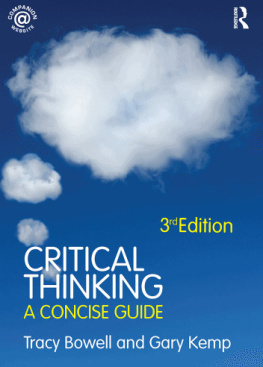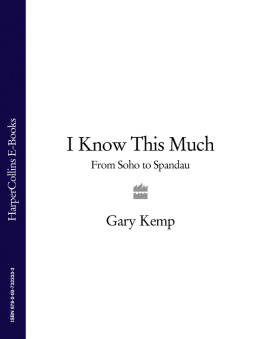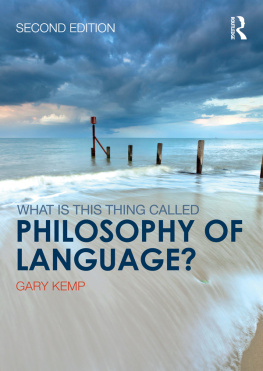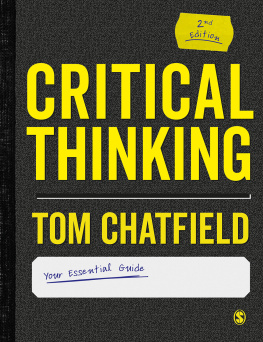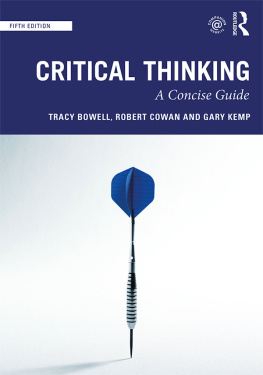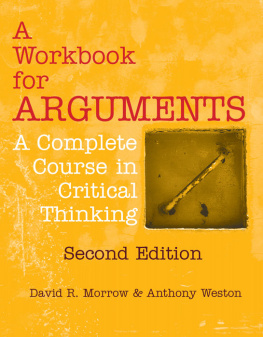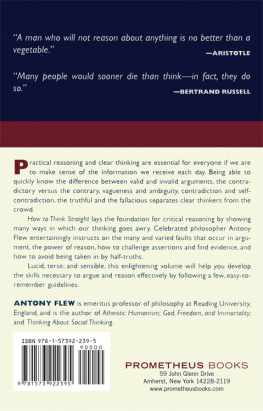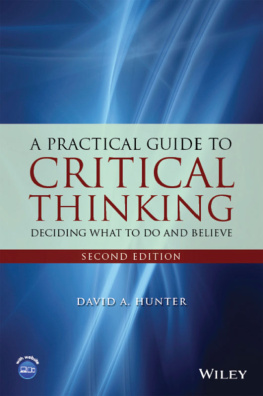
critical thinking
Attempts to persuade us to believe something, to do something, to buy something are everywhere. How can we learn to think critically about such attempts and to distinguish those that actually provide us with good reasons for being persuaded?
Critical Thinking: A Concise Guide is a much-needed guide to argument analysis and a clear introduction to thinking clearly and rationally for oneself. Through precise and accessible discussion, this book equips students with the essential skills required to tell a good argument from a bad one.
Key features of the book are:
clear, jargon-free discussion of key concepts in argumentation
how to avoid common confusions surrounding words such as truth', knowledge' and opinion'
how to identify and evaluate the most common types of argument
how to spot fallacies in arguments and tell good reasoning from bad
topical examples from politics, sport, medicine and music; chapter summaries; glossary and exercises throughout.
This third edition has been revised and updated throughout, with new exercises and up-to-date topical examples, including: real-world' arguments; practical reasoning; understanding quantitative data, statistics, and the rhetoric used about them; scientific reasoning; and expanded discussion of conditionals, ambiguity, vagueness, slippery slope arguments, and arguments by analogy.
The Routledge Critical Thinking companion website features a wealth of further resources, including examples and case studies, sample questions, practice questions and answers, and student activities.
Tracy Bowell is senior lecturer in Philosophy at the University of Waikato, New Zealand.
Gary Kemp is senior lecturer in Philosophy at the University of Glasgow, UK.
Reviews of earlier editions
This concise guide offers relevant, rigorous and approachable methods The authors focus on analysing and assessing arguments in a thoughtfully structured series of chapters, with clear definitions, a glossary, plenty of examples and some useful exercises.'
Will Ord, Times Educational Supplement
In my view this book is the most useful textbook on the market for its stated audience. It provides exceptionally clear explanations, with sufficient technical detail, but without over-complication. It is my first-choice text for teaching critical thinking to first-year undergraduate students.'
Dawn Phillips, University of Southampton
written with actual undergraduates, and the standard mistakes and confusions that they tend to be subject to, clearly borne in mind'
Helen Beebee, University of Manchester
This is the best single text I have seen for addressing the level, presumptions, and interests of the non-specialist.'
Charles Ess, Drury University
critical thinking
A CONCISE GUIDE
TRACY BOWELL
and
GARY KEMP
3RD EDITION
LONDON AND NEW YORK
First published 2002
This edition published 2010
by Routledge
2 Park Square, Milton Park, Abingdon, Oxon OX14 4RN
Simultaneously published in the USA and Canada
by Routledge
270 Madison Ave, New York, NY 10016
Routledge is an imprint of the Taylor & Francis Group, an informa business
This edition published in the Taylor & Francis e-Library, 2009.
To purchase your own copy of this or any of Taylor & Francis or Routledges collection of thousands of eBooks please go to www.eBookstore.tandf.co.uk.
2010 Tracy Bowell and Gary Kemp
All rights reserved. No part of this book may be reprinted or
reproduced or utilised in any form or by any electronic,
mechanical, or other means, now known or hereafter
invented, including photocopying and recording, or in any
information storage or retrieval system, without permission in
writing from the publishers.
British Library Cataloguing in Publication Data
A catalogue record for this book is available from the British Library
Library of Congress Cataloging-in-Publication Data
Bowell, Tracy, 1965
Critical thinking: a concise guide / Tracy Bowell and Gary Kemp. 3rd ed.
p. cm.
Includes bibliographical references and index.
1. Critical thinking. I. Kemp, Gary, 1960 Oct. 14 II. Title.
B809.2B69 2009-07-10
16dc22
2009002265
ISBN 0-203-87413-7 Master e-book ISBN
ISBN10:0415471826 (hbk)
ISBN10:0415471834 (pbk)
ISBN10:0203874137 (ebk)
ISBN13:9780415471824 (hbk)
ISBN13:9780415471831 (pbk)
ISBN13:9780203874134 (ebk)
Copyright 2008/2009 Mobipocket.com. All rights reserved.
Reader's Guide
This ebook has been optimized for MobiPocket PDA.
Tables may have been presented to accommodate this Device's Limitations.
Table content may have been removed due to this Device's Limitations.
Image presentation is limited by this Device's Screen resolution.
All possible language characters have been included within the Font handling ability of this Device.
CONTENTS
PREFACE TO THE THIRD EDITION
Like all authors of texts on critical thinking or critical reasoning, we have tried to write a book that is genuinely useful. But our conception of what is useful differs somewhat from that of most of those authors.
On the one hand, we have avoided formal logical methods. Whereas the application of formal methods is justified primarily by its value in coping with complex logical structure, the logical structure of everyday argumentation is very seldom so complex that an argument's validity, or lack of it, cannot be revealed to ordinary intuition by a clear statement of the argument in English. Yet no formal means short of the first-order predicate calculus is sufficient to represent the logic of the majority of everyday arguments. Rather than compromise by presenting less comprehensive formal methods that are useful only in a narrow range of cases, we have avoided them entirely.
On the other hand, we have discussed and employed the concepts of logic more thoroughly than is customary in texts that avoid formal methods. We have defined them as accurately and in as much detail as we could, without superfluous refinement or inappropriate theoretical elaboration. We have done this for three reasons. First, it is only by grasping those concepts clearly that the student can achieve a stable and explicit understanding of the purposes of presenting and analysing arguments. Second, facility with those concepts enables the student to think and to talk about arguments in a systematically precise way; it provides a common currency in terms of which to generalise about arguments and to compare them. Third, experience, including our teaching experience, suggests that the concepts of logic themselves, when they explicitly appear in argumentative contexts, are amongst the most persistent sources of confusion. A symptom of this is the relativism that is so often encountered and so often lamented. At the root of this, we assume, are certain equivocations over the word truth'. We have tried to clear these up in a common-sense and non-dogmatic way, and thereby to clarify further concepts that depend on the concept of truth, such as validity, probability, inductive force, soundness, justification and knowledge. We hope that clarity about these concepts, and the ability to use them with confidence in analysing arguments, will be among the most valuable accomplishments to be acquired by studying this book.
Next page
